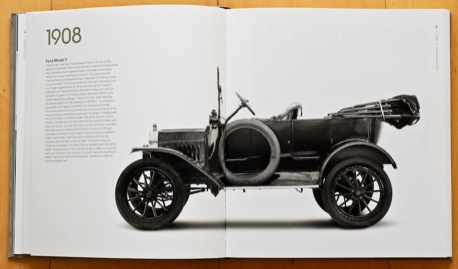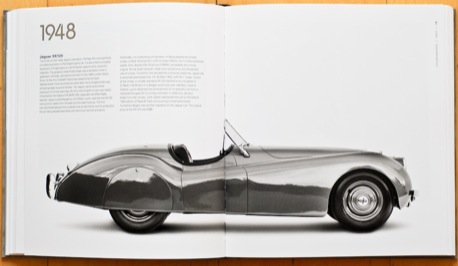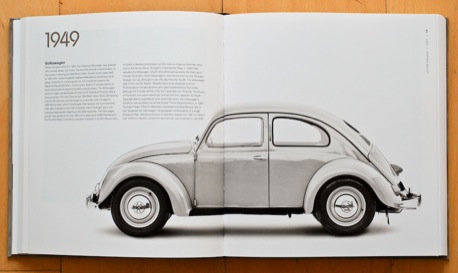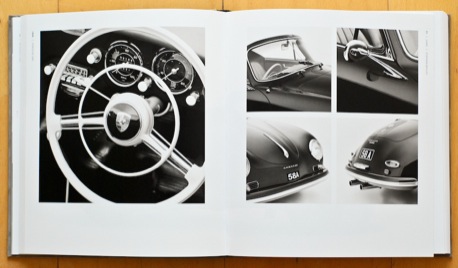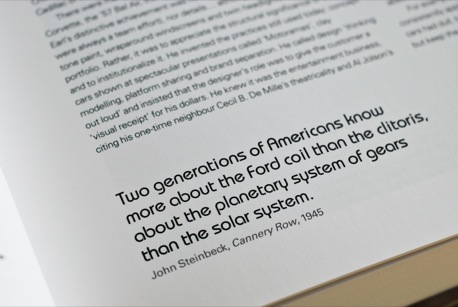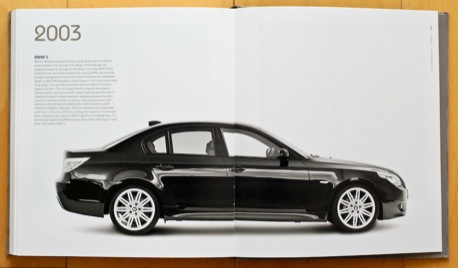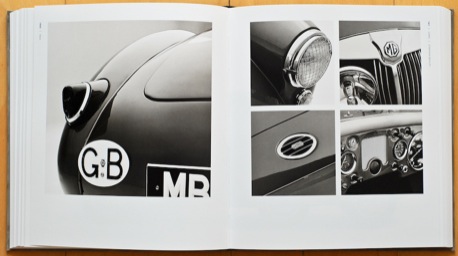Cars: Freedom, Style, Sex, Power, Motion, Colour, Everything.
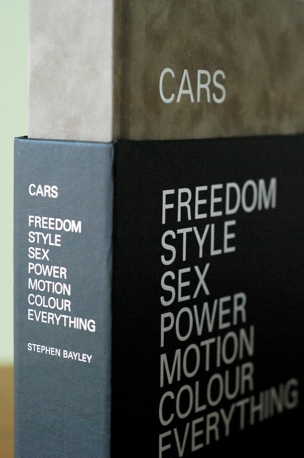
The car sums up the contradictions of industrialised age more than any other design object. Simultaneously a symbol of desire, design and engineering brilliance and of over-consumption of resources and destruction of the environment.
The subtitle to Stephen Bayley’s Cars (Amazon: US



(Click to enlarge)
Bayley’s opening essay is as insightful as it is well-researched and traces the parallel developments of automobile design culture in the USA and Europe. He opens with, “this is not a book about cars”. Not in the sense of their power or speed or any other technical details. This is a book that luxuriates in the the power of design and of the generations of automotive designers who designed these objects that, in turn, inspired the rest of us. Here the car is an artform, “our age’s singular contribution to cultural history.”
“The ‘57 Chevrolet Bel Air is as least as interesting as a ‘57 David Smith… with the added significance that it sold more. No formula exists to calculate aesthetic impact, but my feeling is that the Chevy – in the general scheme of things – outperforms the gallery sculpture.”
(Click to enlarge)
The story is not only about the cars, but the personalities behind them. Car designers are seldom known outside of their own sphere, a curiosity given their mass production and appeal. I would wager more people would recognise the name of Philippe Stark than J Mays or Freeman Thomas (the designers of the Audi TT).
From Ford’s relentless drive (sorry…) towards ever-increasing efficiency to the enormous, curvy opulence of GM’s cars under Harley Earl, the car gave birth to many of the modern notions of industrial design – a contribution often excluded from Bauhaus-laden design histories.
“Without books to teach them, car designers have learnt a potent formal language: how one radius can convey strength, another weakness. They learn also about meaningful detail, the psychology of colour, proportion and the way light falls on surfaces. And they pass on these lessons to consumers.
“Car designers learn to work within astonishing constraints, not just of technology, but of aesthetics, too. There is only a few millimetres’ difference, Jaguar designer Geoff Lawson once explained, between a curve that is fat and a curve that is anorexic.”
(Click to enlarge)
GM’s Chairman, Alfred Sloan, pondered in the ’20s whether ‘appearance’ might be a way of selling more cars. But it was Earl who gave birth to the notion of ‘Styling’ when he renamed his still fresh “Art and Color” department.
“Earl’s distinctive achievement,” writes Bayley, “was to appreciate the structural significance of design and to institutionalize it.”
“He invented the practices still used today: concept cars shown at spectacular presentations called ‘Motoramas’, clay modelling, platform sharing and brand separation. He called design ‘thinking out loud’ and insisted that the designer’s role was to give the customer a ‘visual receipt’.”
Raymond Loewy, ‘the Father of Modern Industrial Design’ (and who also designed the Shell logo) understood the need for car designers to lead the public’s taste with his MAYA – “Most Advanced Yet Acceptable – principle. Enough of a dream, but pulled back from the bleeding edge with enough space for next year’s model.
(Click to enlarge)
Across the pond (where the technology of the car was invented by the Germans and Austro-Hungarians) there was also plenty happening. Bayley drools over the Citroën DS – “the single greatest automobile design of all time” and smirks at the phallic form of the Jaguar E-Type – the first mass produced car to be exhibited at MoMA in New York.
There are plenty of anecdotes, egos and intrigues, whether it is Roy E. Brown saying, “I have so much talent, it frightens me” or Bayley’s quip that Enzo Ferrari’s “intractable ego and monumental conviction of self-worth could not be accommodated in anybody else’s corporate structure”.
(Click to enlarge)
The main book itself is classic car porn. Each selected car gets its own centrefold with a following spread of details, all beautifully photographed by Tif Hunter, who took a tent with him around the world to photograph them all in the same environment. Each earns a paragraph of pithy historical and critical analysis from Bayley.
(Click to enlarge)
All the classic supercars, Cadillacs and vintages you might imagine are in there plus some surprises and some oddities, such as the Nissan Cube – a car I hold to be the ugliest of all time. The smart makes an appearance and it’s entertaining to flip between the pages of it and the Mini or Fiat 500. The line-up ends with the shark-fin BMW 5 from 2003 – a car I regularly see on the autobahns here in Germany, usually in my rearview mirror closing in at 240km/h and flashing their lights.
(Click to enlarge)
Some people bristle from Bayley’s tendency to be either a highly entertaining, knowledgeable guide or a cocky know-it-all (who else puts a quote on their own web site that they were ‘once described as the second most intelligent man in Britain’?) But I have admired his mix of intelligent critique and wit since reading General Knowledge
(Click to enlarge)
Cars is a gorgeous book. It’s worth buying for the production – velveteen cover and library-grade slipcase – and the photography alone. Bayley’s essay and analysis add up to something much more – a eulogy for the car as we have known it.
I can’t feel sad about this, the time has come and I already feel a revulsion at the site of a Hummer’s ugly, blunt obscenity even whilst admiring the enormous cruise ships of cars from 50s Americana. The difference between the two is the consciousness of the age in which they were designed (and that the Hummer lacks any grace).
But transport will and must change and the car with it. I sit writing this in Germany where the car industry is reeling from the financial crisis and Opal looks set to be dragged under by its mother company, GM – both of whom have been making uninspired cars that nobody wants for far too long. Change is fuel for innovation.
It seems likely, however, that we will never see the combination of the thrill of riding a galloping horse combined with the adventure of a rocket ship in the car again. Cars: Freedom, Style, Sex, Power, Motion, Colour, Everything is large enough to make a beautiful tombstone for a dying era of design.
Cars by Stephen Bayley Hardcover: 384 pages Publisher: Conran Octopus Ltd.
You can buy Steven Bayley’s Cars: Freedom, Style, Sex, Power, Motion, Colour, Everything from Amazon (US


[Update on the US release: Octopus will be publishing a pocket sized version of the book in May and then the larger version of the book (the one I reviewed) in November. You can still buy the book from anywhere in the world through the Octopus web site.]



